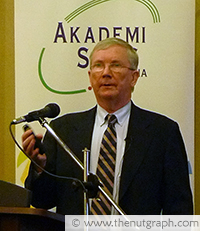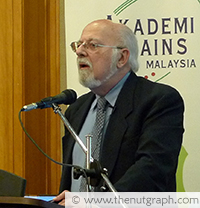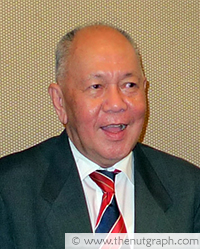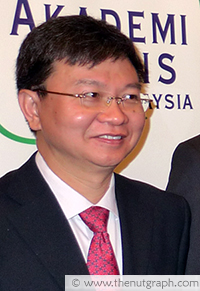CONTROVERSY surrounding the rare earth refinery in Gebeng, Pahang has generated lively, and sometimes polarising, debate among those who support and those who oppose Lynas Corp. The debates have, among others, centred on the refinery’s impact on the environment and local communities, and the government’s role in the matter.
In August 2011, local experts from the Academy of Sciences Malaysia (ASM) and the National Professors’ Council also weighed in by producing a report on rare earth industries. The report acknowledged that the industry presents both economic opportunities and environmental and health risks to local communities. The academy invited four foreign experts to visit the Gebeng plant, and asked them to give their views in a 9 May 2012 public forum.

What do the Academy of Sciences and the four experts think about the rare earth refinery in the east coast of Peninsula Malaysia? And what will it take to remove opposition to a project that brings economic benefits just as it stokes fears for public safety and health?
Evaluating the refinery

After their 8 May 2012 visit, all four experts, from Canada, the US, China and Germany, agreed that the Lynas Advanced Materials Plant (LAMP) was well designed. Alastair Neill, a trained engineer and executive vice-president of Dacha Strategic Metals, described the refinery as a “world-class facility”. The Canadian, who has been in the industry since 1995, thinks the Gebeng refinery is the best among the plants he has seen in China and Japan.
Neill noted that Lynas would attract a lot of downstream companies to Malaysia as demand for rare earth elements in the green technology sector was fast rising. To illustrate, he said rare earth metals are commonly used to manufacture the more energy-efficient compact fluorescent light bulbs. He noted that China produced 62 million compact fluorescent light bulbs in 2008 and the production doubled a year later.
In addition, Neill highlighted that a hybrid or electric car uses around 10kg to 12kg of rare earth metals while wind turbines of one-megawatt capacity, made of neodymium magnets, use about 400kg.

Founding principal of Technology Metals Research, Jack Lifton, remarked that Lynas is Malaysia’s “gateway to 21st century technology”. The American expert has been involved in the rare earth industry for 48 years and thinks the pollution risks posed by the chemical plant are “low” and manageable.
Be transparent and proactive
According to the ASM report, the Lynas refinery will generate three types of wastes — Water Leach Purification (WLP) residue, Flue Gas Desulphurisation residue and Neutralisation Underflow (NUF) residue.
Lynas claims it has developed a method to dilute the concentration of radioactive thorium and uranium in its WLP residue from six Becquerel per gram to below one Becquerel per gram, the limit set by the Atomic Energy Licensing Board (AELB). The company is confident it can recycle its diluted WLP residue as road base and NUF residue as fertilisers.
Nonetheless, the International Atomic Energy Agency had, after its visit in June 2011, recommended that the company locate and build a permanent disposal site in the event that Lynas failed to commercialise its waste residue.
Prof Dr Yan Chun-Hua from Peking University said Lynas should make public its dilution method of the WLP residue to sooth public concerns over radiation pollution. “[Consult] the public, never fight (with them). The public is always right. They complain and raise questions because they’re concerned. If you can convince the public, they’ll support your project,” said the chief scientist on rare earth functional materials from China’s Science and Technology Ministry.

ASM senior fellow Lee Yee Cheong, who moderated the discussion, also conceded that the lack of public consultation prior to the project’s approval had fuelled deep distrust between the local communities and the government. He said a detailed environmental impact assessment, instead of a preliminary environmental impact assessment, should have been carried out.
“Going forward, the government must consult the local communities (before approving a project of such scale),” said Lee. He added that ASM recommends that the government commissions a university to carry out a long-term baseline health study to monitor the refinery’s impact on surrounding communities.
Lee said the government should also help clean up the Gebeng industrial zone as some of the existing chemical plants have polluted the environment. “Any development must be green and clean,” he stressed in his concluding remarks at the forum.
Engage and be open
What with the parliamentary select committee and media visits organised by Lynas, Himpunan Hijau and other anti-Lynas groups have clearly succeeded in pressuring the government and the corporation to be more transparent about the refinery’s operations.
Now that the communication channels are open, local communities should continue to ask more questions. These questions could be to find out how Lynas plans to deal with its residues, and whether a permanent disposal facility is needed as different parties seem to have differing views.
For now, the crux of people’s opposition to the refinery lies in fears about the radioactivity of the waste that will be produced. If expert and independent scientists can be convinced that the plant’s operations can be conducted in a way that makes it safe, shouldn’t those who oppose the Lynas plant be open towards different views so long as they are supported by facts and science?

At the same time, Lynas would do well to regain public confidence by making its processes for dealing with the radioactive waste as accessible as possible to experts and the public. Peking University’s Dr Yan said as much when he was asked to comment on the viability of Lynas recycling its radioactive waste. “I didn’t see the detailed parameters (of the study). But I think Lynas should release the data so the public can [evaluate it].”
By doing so, Lynas would prove that it had nothing to hide. And it would also ensure that any radioactivity will effectively be dealt with through a process that is robust and that has been peer-reviewed. And if the radioactive waste can be dealt with to ensure no public harm, why should there be any more opposition to the rare earth refinery in Gebeng? ![]()
Gan Pei Ling is still learning something new about rare earths and sustainable development every other day. She thinks it’s important to keep an open mind when engaging on any issues.
[related-posts]


Kong Kek Kuat says
“Lee said the government should also help clean up the Gebeng industrial zone as some of the existing chemical plants have polluted the environment.”
Ho ho ho… there you go, what almost all of the anti-LAMPs already subconsciously fear.
The anti-LAMPs are probably imagining what would happen to them if the already polluted environment also includes the wastes from LAMP ten years down the road. Can we depend on the Malaysian Government to protect us against chemical pollution? Can we trust that they will protect us and the environment our children and grandchildren will be growing up in by rigorously enforcing the conditions set upon LAMP and the other chemical plants in any part of Malaysia? Naa… I don´t think so.
TNT says
KKK. Going by your logic about rejecting Lynas because it will create similar waste that is already at Gebeng, does it mean we should now reject Gebeng and close Gebeng down? If no, why pick on Lynas because her waste is more of chemical waste and no more dangerous than other chemical waste from other chemical factories.
Kong Kek Kuat says
@ TNT
Again, what a waste of your time and effort. I just don´t understand what you are trying to say, even if you are apparently trying, which reminds me of those collared component parties under UMNO — I can never understand what they are trying to say, e.g. “we MCA are the only party in Malaysia representing the Chinese and their interests,” or Gerakan… well… even UMNO can´t understand them. Anyway. Regarding your reply, well if Lynas is not there yet, how can there be “similar waste that is already at Gebeng”? You are either ignorant for trying to say that LAMP is similar to ordinary chemical plants at Gebeng, or you think people are stupid for not thinking so.
KK Aw says
Why did China impose an export quota on rare earth metals when they have a near monopoly on its production? Since rare earth is not really rare, their actions will actually break their monopoly. Today, new rare earth mines and processing plants all over the world are now under construction. Before long, we should see prices of rare earth metals dropping drastically.
The answer to this question may enlighten us on the hazards associated with the Lynas plant in Gebeng.
I think it is nonsense that Lynas will attract downstream companies to Malaysia, unless we also impose an export quota. Otherwise, the weight of the metal used is not so significant that the companies must be located near the supply. Remember, the earlier Japanese rare earth plant in Bukit Merah was for export to Japan.
Kong Kek Kuat says
@ KK Aw
Like I said, the ASM-NPC report is more like 78 pages of selling.
Can you imagine, our academic level has come to this stage where academy scientists and university professors are doing sales job for the government?
KK Aw says
What to expect? Both organiszations are effectively government agencies. ASM gets its funding from MOSTI and NPC is headed by the Science Adviser to the PM.
Pei Ling says
KK Aw, the argument you’ve put forth is not unlike those who accused Bersih of being a foreign puppet simply because they have accepted overseas grants.
If you read the ASM-NFC report, the scientists do acknowledge that Lynas presents business opportunities but there are environmental and public health risks involved. If the scientists didn’t care about the local communities, why bother suggesting to the government to conduct a baseline health study before the refinery starts operating, among other recommendations?
ck says
The business opportunities mentioned can only be those of primary source & low skilled set, ie refinery & extraction only. These are the industrial business that most of the advanced nations DON’T want to have!
Currently, most of the REE industrial applications involve REE purity levels that M’sia is NOT able to achieve, even if there are willing oversea investors, to supplement with their technical expertise. Moreover, in such a high tech environment, pay is not the issue but human skill, that M’sia is highly lacking.
In short, those beneficial, high profitability & low risk commercial applications of REE wouldn’t be available to M’sia until M’sia reaches a high level of technical skill set.
M’sia can import the expertise, but like I mentioned earlier, there is just no commercial justification of any kind at the near horizon.
So for the near future, any REE operation will only be those that the advanced countries are not willing to uptake, due to the various human & environmental issues.
ASM-NFC is living in an ivory tower.
KK Aw says
Pei Ling, there is a big difference.
One is to say that Bersih is a foreign puppet because they have accepted overseas grants. This is a blanket statement that is unfair and illogical.
What I am saying here is that ASM-NPC are promoting an agenda, and this is apparent in their report. To understand why they do this, we need to investigate into their background. I know the constraints my friends in ASM are working under.
No doubt the report included some very interesting scientific facts. However, when they venture into economic projections, we have to be aware that this is speculative at best.
The tin mining industry, in which I spent 13 years of my early career, is very different. We were making more and more of the mining and dredging equipment locally until the industry collapsed around 1986. Many workshops and factories were established to support the industry. This equipment and expertise were exported to other mining operations around the world. I was part of this history. As for the use of the tin metal and R & D on its use, hardly anything was happening here.
Our biggest economic opportunity is the taxes on the revenue, but the government had chosen to “give” that away.
Kong Kek Kuat says
@ Pei Ling
Let´s assume that we are neutrals (which I actually am, believe it or not).
Let´s assume that the ASM-NPC report is a non-scientific report. Let´s also ignore the fact that the report is titled “Rare Earth Industries: Moving Malaysia´s Green Economy Forward” (but which is supposed to be about LAMP).
Do you think that the contents of the ASM-NPC report are balanced?
TNT says
Kong Kek Kuat. You shouldn’t judge a book or report by it’s cover aka the title. Instead, you should judge it by it’s content. If the contents are true or correct, then it is balanced. If the contents are lies, only then is it not balanced.
KK Aw says
@TNT,
Chapter 4 of the report is entitled “Rare Earth Industries: Strategies for Malaysia” is all 4 pages long. In it, the ASM-NPC could prescribe the strategies for Malaysia without any justification.
One of the recommendations is: “Undertake a national exercise to map the potential rare earth deposits and evaluate their economic potential. This will be the start of a national enterprise for our mining renaissance.”
It sounds as though it can be done with remote sensing. With tin mining in Malaysia, we had to do bangka drilling – a very tedious and expensive process. With the large tin deposits in Brazil, they did try remote sensing with infrared images in the Amazon, but this is mainly to discover areas with potential mineral deposits. This has to be followed up by drilling on the ground.
The tin fields in Malaysia are now largely built-up areas. There are some known large tin deposits, but they are more than 60 metres underground, and it is overlaid by a layer of hard schist. I wonder how this can be mapped. It sounds more like wishful thinking.
My colleagues and I are the remnants of the tin mining industry and we are way past the retirement age. Where is the documentation of the tin mining industry – technology, practices, etc. My ex-boss David Palmer took the trouble to write the book “Tin Mining in Malaysia, 1800-2000” (ISBN 978-967-10295-0-3) for Muzium Gopeng. Beyond that, what is preserved? So, a mining renaissance looks like another pipe dream.
Kong Kek Kuat says
@ TNT
Really?
Yi Yong says
(1) Economic opportunities? Why a 12-year tax exemption amounting to billions of ringgits?
(2) Only 1% is contributed to entire Malaysia economic output, with Malaysians’ (especially those near the LAMP vicinity) health at stake!
(3) 0.05% revenue will go to the Malaysia’s AELB. Since AELB is benefiting from the Lynas project, shouldn’t they be excluded in making any crucial decision?
(4) It started way back in the year 2009, why were Malaysians kept in the dark? It’s obvious someone / some party is definitely benefiting from approving it in the first place. Corruption?
(5) Read this for better understanding http://www.imag.com.my/readstory.php?id=606
TNT says
No amount of public engagement will do when you have DAP […] linking Lynas with Fukushima as stated in the state assembly recently. This is deliberate misinformation to crease fear. This is obviously not an attempt to solve [the] matter but to complicate the matter instead.
KK Aw says
I fully agree with you. The anti-nuclear people are also trying to liken the deaths from the tsunami with the Fukushima nuclear incident.
We need a different way for public engagement. Check out http://www.ncdd.org/rc for resources on this and http://bit.ly/uSbP9e for [what] I am proposing.
hclau says
Hai KK Aw,
This is HC Lau. Good to know you are alive and kicking and is as opinionated as ever.
While I have no objections to a rare earth plant, I do object to the siting of such a plant in a heavily populated area. As far as the “report” singing praises for the development of “Rare Earth” industry in Malaysia is concerned, it is just an advertisement, much like the “whiter than white” stuff we have seen for years. This LAMP Plant of Lynas will contribute as much to the development of the rare earth industry of Malaysia as a solar hot water system will contribute to fundamental energy research.
1. Rare Earth is being process at the plant.
2. Mineral ore is imported from Australia.
3. Only 300 employees are needed.
4. All production (10 years worth) is already contracted for sale – overseas – according to Lynas.
5. No research work or workers used or needed.
6. No tax to be collected as Lynas has been given a tax holiday.
7. No requirement for Lynas to prioritise buyers who are Malaysian based.
8. No supply quota for local use to be applied.
Where the heck is the “catalyst” part? The so-called scientist / professors are simply writing a generic piece on the rare earth industry – it does not apply to the LAMP Plant. The LAMP Plant could be in Timbuctoo and the report will stiil have the same relevance to Malaysia.
KK Aw says
Well put HC.
Good to know also that you are alive, kicking and just as opinionated as ever also.
Kong Kek Kuat says
@ hclau
Haha… I agree, well put. It is obvious to those who pay attention.
But hey, not all Malaysians are in the same classroom.